Student Blog
Life Hacks

Welcome to Procrastination Nation! ⟩
January 21, 2022, by Seth
Classes Life Hacks
Hi, my name is Seth, and I am a chronic procrastinator. If you know me at all, this is probably no shock to you, and if you don’t know me that well, please say hello to what should be my hamartia! While I’m laying all of my cards on the table, I should also confess that I’ve procrastinated writing this blog. To be clear, it’s not because I don’t want to write this blog or that I’m so busy that I have so many other things to take care of, it’s that I just live for a deadline. I’ll explain more on that in a sec, but first, we need to dig into the realities of procrastination first.
Procrastination is often only portrayed as this debilitating habit that we must overcome to become masters of time management and there is truth to this! I’m sure many of us are too familiar with procrastination that has been taken too far. Who can’t recall the time they cut things too close or ended up not showcasing our best work? This is a reality of procrastination, but it is not the only reality. Real-life is rarely this black and white and there are some theories to back this up! The Yerkes-Dodson Model (1908) details a quadratic relationship between arousal and performance where there is a range of optimality. Another way to talk about this in occupational therapy is a challenge-skill relationship where that optimal range results in a flow experience; one of complete immersion in the task at hand.
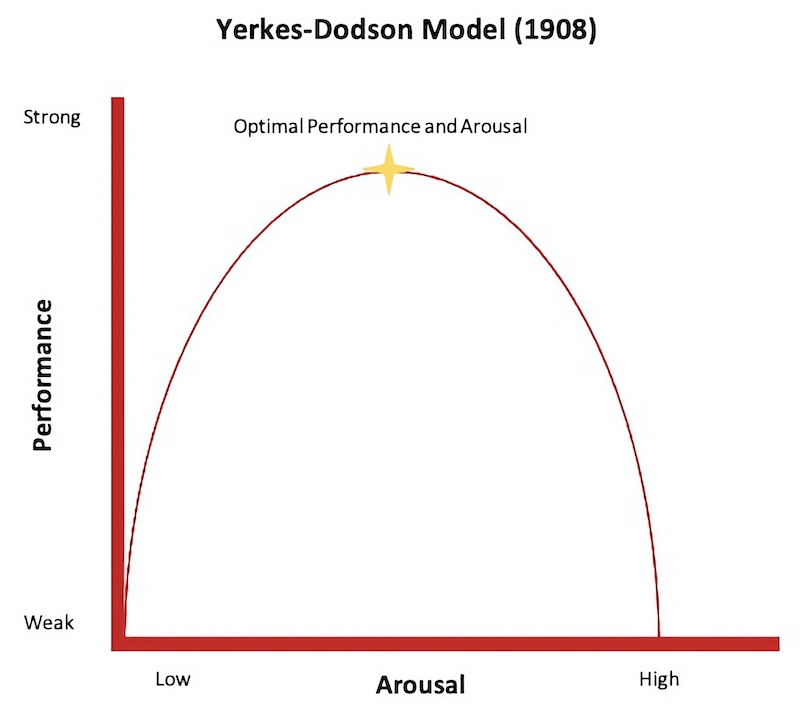
Here’s a visual of the Yerkes-Dodson Model! Everyone’s graph looks different depending on their own internal relationship to arousal and performance.
This is to say that eustress, or good stress, can improve the work you have just as much as the other ranges in this relationship can negatively impact your work. While operating under this perspective I have come to find that, for me, procrastination is less about time management and more about emotional management. Earlier I mentioned that I live for a deadline and this is why! I manufactured the perfect challenge for what I perceive to be my skill and viola! I finally get to the work at hand. By now you’re probably thinking, “This is great news, Seth! I feel so validated, but knowing this doesn’t change the feeling in my gut when I’m procrastinating.” And I’m right there with you, so here are some of the thing’s I’ve found that help me work through that feeling:
Using an Eisenhower Box
The strategy I always have in my back pocket and my first line of defense is the Eisenhower Box. This tool is essentially a way to organize tasks into four quadrants based on urgency and importance. Although I’ve found this is a great way to strategize, I always let my gut feeling play a role in the decision-making process, and I encourage you to do the same.

Here’s an example of my Eisenhower box at the moment! It’s constantly changing and even the tasks showed here can switch quadrants depending on when I re-evaluate my box.
Productive Procrastination
Maybe the best strategy I’ve used to generate enough stress to reach my optimal level is to productively procrastinate. This may mean tackling some of the more non-urgent and less important tasks in your Eisenhower box. This often manifests in cleaning your entire living area before starting your readings or just absolutely having to run that errand before writing that paper. This allows you to get other things done while slowly restricting the avenues you have to procrastinate. This leads me to my next point!
Removing Distractions
This is a natural extension of productive procrastination but goes beyond the things that are also on our to-do lists. I’m talking about our phones, the show we’re binge-watching, or the roommate who decided to invite company over right before that first big assignment is due. For me, this means putting my phone in some random drawer in the kitchen, sitting in a place that is not my bed, and either having absolute silence or music that drowns out whatever other noise is around. Take a look at the things that usually distract you and brainstorm ways to work around them.
Diaphragmatic Breathing
Whenever I think about this strategy, I laugh because breathing exercises have always ended up stressing me out more, but this one is a game-changer. Breathing from the abdomen (as opposed to the chest) is a quick way to elicit relaxation. It can release muscle tension, slow the heart rate, and lead to a hearty supply of oxygen to the blood. Try breathing from your chest and then your abdomen, then take note of any difference. If you’re procrastinating and find yourself starting to breathe from the chest, switch the style up.
Knowing Yourself and the Resources Available
I gave a couple of suggestions that have worked for me, but what it all comes down to is knowing yourself! Reflect on how long things have taken you before, your performance on these tasks, and what strategies work for you in managing your stress and procrastination. If you’re trying to find your optimal performance-arousal range, take note of the stress signs that start manifesting for yourself. Figure out when you’re most productive and take advantage of that time (but don’t be afraid to dedicate it to more meaningful occupations too). If you need some help, don’t be afraid to ask! The USC Kortschak Center, an occupational therapy collaborative resource center, has plenty of strategies and consultations that can get you on the best path for you.
Don’t get me wrong, I am not necessarily endorsing procrastination. All, some, or none of this may resonate with you, but I hope that it encourages you to reflect on your procrastination habits. As we head into the third week of the spring semester, I invite everyone to give themselves a little more grace around their habits. Coming around to see that there can be ambivalence around procrastination is a great step in making positive change. It helps us shift the narrative from thinking “I should stop procrastinating” to “I could do XYZ” to make that change more manageable, intentional, and personalized. So get out there and make the change, or put it off until tomorrow! Either way, I hope you’ve enjoyed your stay in Procrastination Nation.
⋯

Hello Trello ⟩
January 19, 2022, by Alyssa
Life Hacks
Happy new year/new semester to all! Continuing from my last blog, let’s get organized for the semester.
I live laugh love ride and die by my Trello boards. I was introduced to Trello in a coding class in undergrad for the classic use of “to do” “doing” and “done” lists. As someone whose work style leans toward start-to-finish in one sitting, this workflow doesn’t really work for me. Trello is also built for team workflows in mind BUT I realized Trello had a lot to offer for personal organization.
My system is intuitive to me but challenging to explain, so here it is in 4 parts.
1. Multiple boards/visualizations
There are 3 main parts to the anatomy of Trello. “Cards” are single events/tasks. “Lists” are lists of cards. “Boards” are pages of lists. Within each card, you can add sub-checklists, descriptions, and attachments.
I operate my life around 2 boards: my due dates and my schedule. As soon as the syllabus is released each semester, I input all of the due dates into my board and color code them (see #2). This board can be viewed as lists for each class or as an auto-populated calendar of due dates.

Anatomy of a Trello board, featuring one of my class due date lists.
I then update my schedule board roughly every month to schedule out when I’m going to all of that work around my regularly scheduled events (class, appointments, etc.). I add in personal plans and other to-dos as they come up.
2. Color coding
Trello offers 10 colors to label each card. I use these colors differently for each board.
For my due date board, each class gets its own color, and then I additionally categorize each task by type. Yellow for readings, Red for big assignments/exams, Orange for anything in between.
My schedule board is a bit more complicated: class (light blue), homework (dark blue), fieldwork (black) student ambassador work (yellow), OTSC (orange), any other club (mint), important personal to-dos (red), social plans (pink), workouts (purple). I do this so I can see the balance of my day/week. If I notice too much dark blue, I’ll try and rearrange to make sure I have some restorative pink or purple in there.
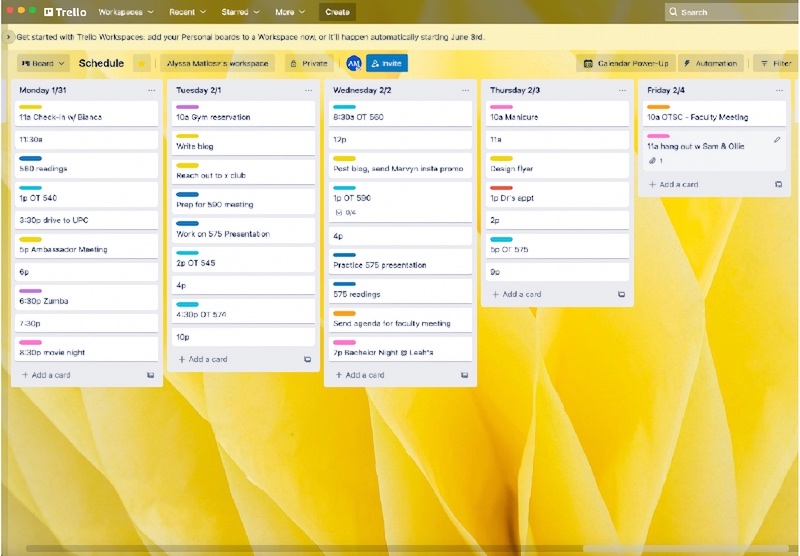
A mock-up of one of my weekly schedules on my Trello schedule board.
3. Keyboard shortcuts
Trello has keyboard shortcuts to add due dates, label cards with colors, create cards from templates, and quickly switch between boards. Using these shortcuts dramatically increases the efficiency of using Trello for scheduling.
My favorite one is hovering a card and pressing C and it disappears, which is how I mark something as ‘done’ — a thrilling mix of achievement and relief.
4. Drag and drop
If I don’t get something done when I planned to, I like how Trello has an easy drag-and-drop feature for the cards. It lets me quickly rearrange my plans/tasks without having to rewrite anything. Honestly, it feels way less shameful and I see it as a metaphor for trying to be more flexible and give myself some more grace.
⋯

So You’re in LA. What To Do? ⟩
January 17, 2022, by Marvyn
Life Hacks Living in LA
Here we go, my first blog of the year! If you read my last blog (which was the last blog of 2021), I said that one of my new year’s resolutions is to take more photos around Los Angeles and to explore new places. I would like to preface this blog by saying that I am an international student and by no means am I a pro at being an LA person. You may be reading this because you’re also an international student, or maybe not even an LA native, but I hope this list can help build your experience here in LA. Personally, as an international student, this is my first time staying in LA for as long as I have. Now while I am still trying to navigate the logistics for 2022 (being sensitive that there is still very much a pandemic going on), I am privileged to have been able to experience LA, even just a tiny bit. Allow me to show you some of my favorite experiences that I have had so far, and how YOU can do it too!
#1: Having a yummy meal in Downtown LA
In LA, there’s a bunch of food spots that you can go try. All I did was hit Google with the keywords, “top places to eat in LA”. From there, you can find a ton of places to eat with food that can be both inexpensive and delicious! Food blogs and YouTube videos have helped me find out cool spots too!
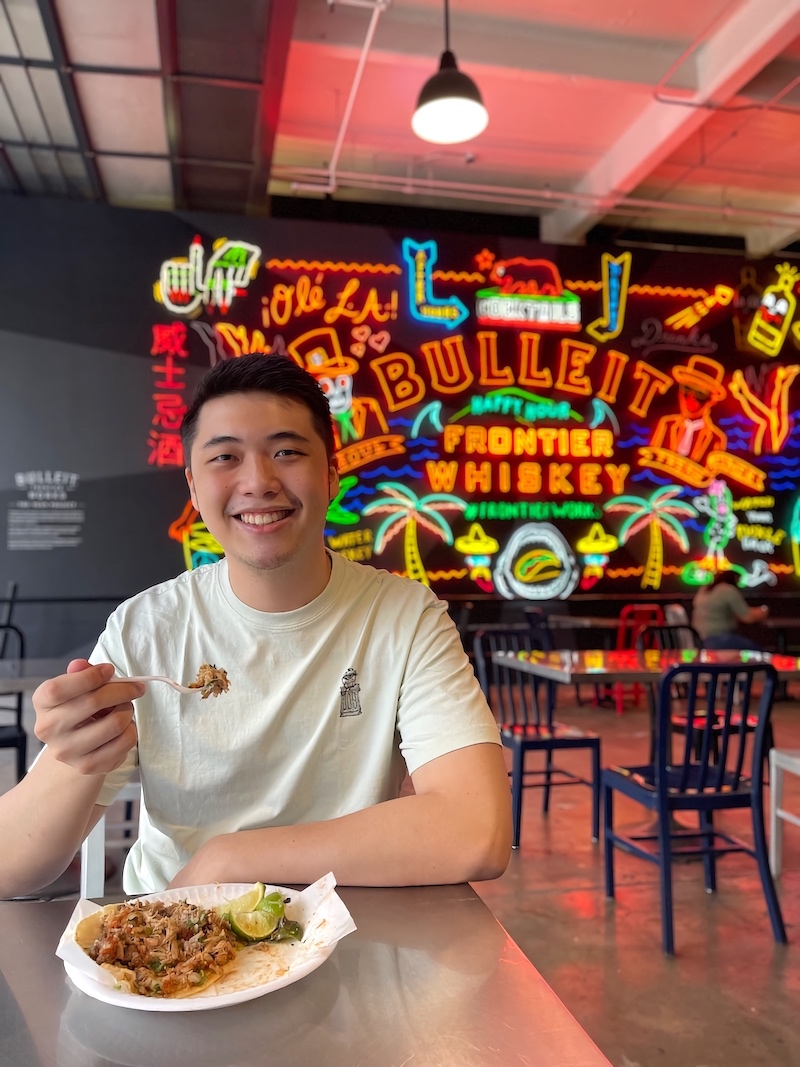
Delicious tacos and a bunch more food at Grand Central Market!
#2: Watching a USC football game with friends
Nothing screams America more than American Football. And don’t worry if you don’t understand the sport. You’ll be surprised to find that there are a bunch of people who watch and yet do not understand what’s going on. I do encourage you to just go in the stadium and feel the school spirit looming around. It’s one of the best feelings to experience as a Trojan! I will say, it’s been quite helpful to watch with someone who actually knows the sport so they can explain things as they happen. (I did my homework prior, and it has been helpful too!)

Go Trojans! With my friends Dustin, Vanessa and Gill at the iconic LA Coliseum!
#3: Experience the social activities (safely, of course)
As an international student, it is also crucial to create good relationships with your fellow students here in Chan. I am so lucky to be working with such a fun, diverse group of people who share the same passion as I have in occupational therapy. Attend events organized by amazing offices such as Global Initiatives. Just put yourself out there, and you’ll quickly realize that there are a bunch of similar-minded people in LA that’s for sure will make you have the best time.

Bonding with my fellow ambassadors, Seth, Teresa, Silvia, and Alyssa!
#4: Hike with your friends
You may or may not like physical activity, but I highly recommend you do at least one hike in LA. Wherever you hike, there are fantastic views and sights to see. You can easily look up fantastic places to hike up and you will be rewarded (almost always) with a breathtaking view of either California or even Los Angeles!

Looking over at the fantastic view in Angeles National Forest with my friends Vivien, Florence, and Josh!
I can go on and on about the things I did so far in Los Angeles and things I recommend doing. And even for me, as I write this, I still have an abundance of activities I have yet to do! My mantra throughout this experience is that: “You are responsible for your own memories. Craft them, and let your stories paint the colors of your life.” You’ll thank yourself down the road with all the stories and memories you have made.
Let me know what you think! If you need more recommendations, keep in touch with me and the rest of the ambassadors at our social media @USCChanOSOT on Instagram. Looking forward to hearing from you! Until then, Fight On!
⋯
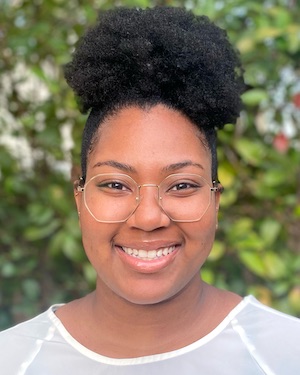
When In Doubt, OT it Out! ⟩
January 13, 2022, by Kayla
Life Hacks
The holidays were amazing, not only because I got to travel back home to California, spend lots of time with my family, and see some of my friends. But also because it came with a much needed break. A break from classes, assignments, presentations and from residency. As amazing as this journey is, sometimes the load does get heavy. This past Monday, the spring semester started and I was admittedly feeling less than inspired logging into my first zoom class of 2022. As an occupational therapist, constantly surrounded by other occupational therapists, sometimes a light bulb goes off to practice what I preach. I call it “OT’ing myself.” While settling back into my typical workflow I’ve decided to focus on engaging in some of my most meaningful occupations to fill my cup and replenish my energy so I can be the best version of myself. This week I’ve been more intentional with:
Listening to Music:
My days have been filled with music and singing and dancing (badly) around my house after work. I play my favorite playlist when I wake up in the morning, look for new songs in my free time, and play my go-to feel good songs when I’m sitting in traffic.
Exercising:
As an ex-college athlete, I have recently found myself missing my playing days a lot more than usual. And although I can’t go to the gym and play pick-up games because of covid, I have been more diligent with getting some form of exercise everyday. Taking online cycling classes with my favorite instructor and a few friends has been helping to keep me in the right mindset!
Cooking:
I absolutely LOVE cooking, and I love trying to make new recipes even more-so. This week I searched my saved videos on TikTok to find those recipes that I saved and forgot about . . . and actually made one! It was delicious, if I do say so myself, and exactly what I needed.
I’m also starting to write down all of my favorite recipes to make and making my own personal cookbook. So stay tuned for that in a book store near you. 😉
Sleeping:
New year, same me. Like I may have mentioned before, I am a self-proclaimed sleepy girl. I love love love sleep, but I am also a night owl so I can never seem to get enough of it. So this week I made it a priority to go to sleep earlier to hopefully set myself up to have more peaceful mornings and have more energy throughout the day. Next skill to master, waking up on time.
As we head into the first Friday of the semester, I am feeling more ready to take on the semester thanks to this wonderful profession that I get to practice everyday, and remember, when in doubt, OT it out!
⋯

TwentyTwenty-ONE: The Ambassador Year Round-Up ⟩
December 31, 2021, by Marvyn
Diversity Life Hacks What are OS/OT?
Happy DAY ONE (and sadly last) day of Blog-mas! It has been such a blast reading everyone’s blog entries over the past 2 weeks. I hope that this Blog-mas helped you in any shape or form during the holidays! But if you come across this blog at a random point in time in the future, welcome!
For the last blog post of 2021, I decided to round up all the current ambassadors to create this collaboration blog! Call it “The Avengers” of blogs if you will. Crossover blog of the year! While I don’t get carried away, I asked each ambassador the following questions: “What have you learned in life from 2021?” and “What is your TOP GOAL for 2022?” Let’s see everyone’s responses!
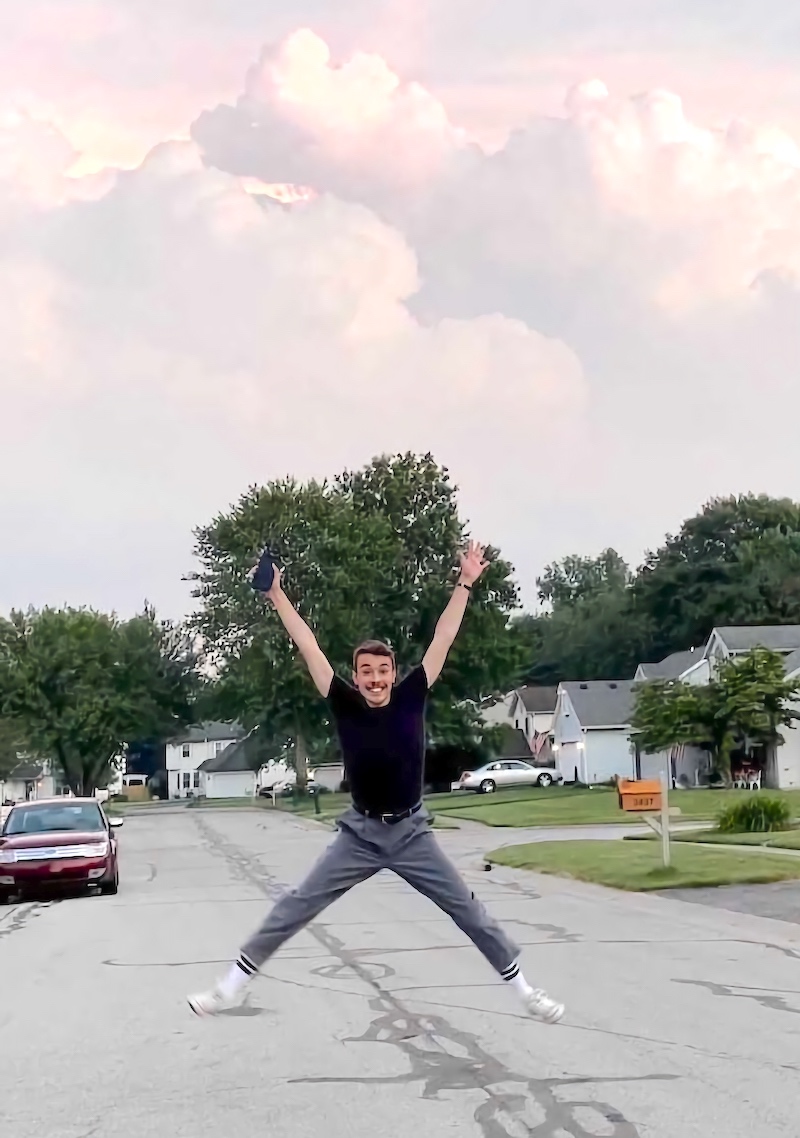
SETH: “As I look back on 2021 what I’ve learned is that no matter how much you grow and transplant yourself, you always have your roots. Up until this past year, I couldn’t wait to get out of my hometown and escape to the big LA city, but after a couple of months of quarantine, I really began to discover a newfound and indescribable appreciation for the place and people that raised me. When we slowly began to transition back to in-person classes I realized how much I missed the peace and quiet, the dinners with my family, and the pace of life. After five years, I felt like, for the first time, I had feet firmly planted in both places. At a point in my life where I am figuring out the next steps, it is nice to know that I have it in me to be adaptable, but also that I have a place that fits the stereotype of a home is where the heart is.
As I look forward to 2022 my top goal is to spend more time doing the things that mean the most to me and to find more small moments of joy throughout my day. It is easy to fall into a slump or get busy or to focus on what might not be going as planned, but being able to feel those things, quickly shift perspective, and take action is a philosophy that I’d like to more seriously put into practice. I always come around eventually, but by being more mindful, more present, and more intentional I believe I could enrich my 2022 experience. Big things are on the horizon and I want to give them, and myself, the love and attention they deserve! Here’s to the new year and new habits, roles, and routines!”

KAYLA: “While this year has taught me a lot, more than anything I learned how to enjoy the journey. When faced with difficult situations I am always anticipating something going wrong, and pre-stressing about fixing problems. This year I really tried to change my thinking from “what if it goes wrong” to embrace the ideology of “what if it goes right”. This subtle change has helped me be more present for the huge changes happening in my life, allowed me to be more mindful, and have the capacity to enjoy my experiences in the moment rather than having to reflect on them later down the line.
During this next year I want to be really intentional with what I do and how I spend my time. I am a self-proclaimed “sleepy girl” and will choose sleep over anything 9 times out of 10. In 2022, I want to take advantage of more opportunities to step outside of my comfort zone. I want to go new places, try new things, and have new experiences all 2022!”
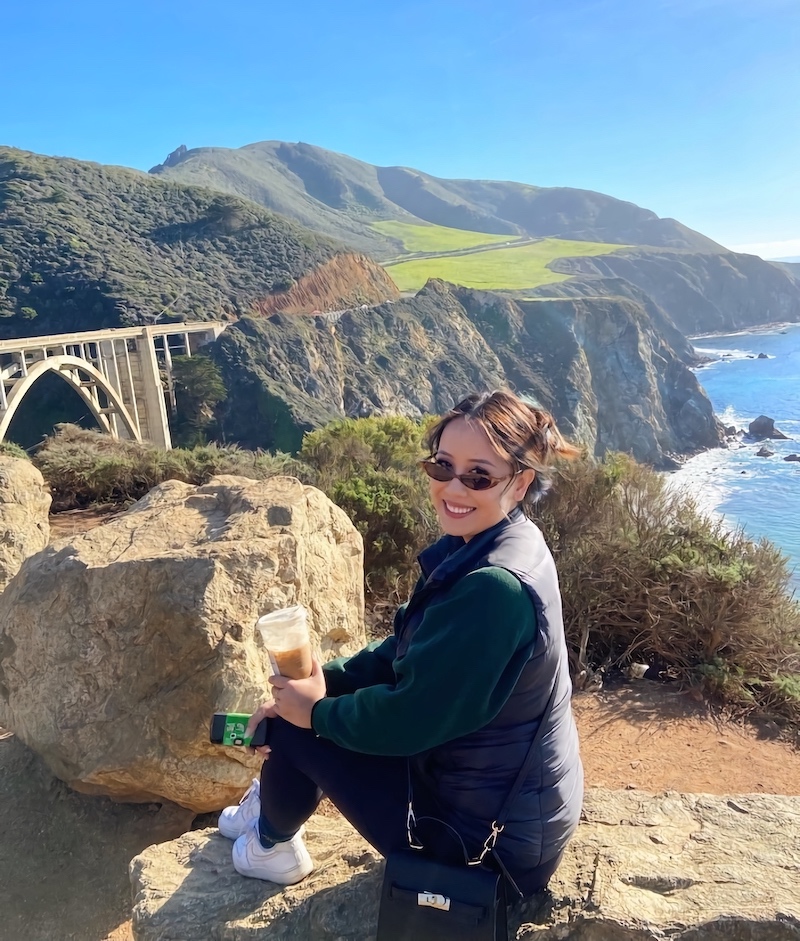
TERESA: “Looking back, I accomplished each goal I set for myself in 2021, which is not something I’ve been able to say in a while. I think this was due in part to my primary goal for the year, which was to accept that so many things in life are out of my control and to learn to be okay with that. However, I can be in control of the way I act and react to situations. With this approach, it allowed me to tackle goals which were internally motivated but contingent on an external source and completely out of my control.
In 2022, my only resolution is to show more self-compassion and for some reason, that seems more daunting a task than prior years. I am my own worst critic because I always thought if you’re self-aware of every single one of your flaws, then no one else can use them against you . . . right? Except in 2021, I realized that I tend to use them against myself. As a student and future OT, I’m always reminding myself that I can’t pour from an empty cup but I also need to remember that outside of those roles, I am also human. As a human, I’m inevitably going to mess up but despite these mistakes, the person I need forgiveness and validation from most is myself. Also, the members of BTS said to “Love Yourself” so, in 2022, I will be. I’m going to accept love from the world, from those I love, from myself, and return that love tenfold.”

SILVIA: There’s more to life than ___.
For a long time, my life has revolved around school and family, two very important things to me. From wanting to perform at the top of my class to trying to mediate family tensions, these two aspects of my life have also brought the most stress and anxiety. This year, I have found myself sitting in the ugly and telling myself, “There has got to be more to life than this.” “This” stands for the feelings, the worries, the distress — everything that is making me unhappy at that given moment. This reminder has allowed me to sit, feel, and embrace my emotions . . . and then let them go so that I too can keep going.
Top Goal for 2022: Learn to Adult.
Some may say that I entered adulthood a couple years ago, but that is fake news. Truth is, I am turning 26 this year (next month actually) and that means going through the rite of passage that marks my transition into adulthood: getting kicked off my parents’ health insurance. In light of this, I have made a list of “important things I must learn to do as an adult.”
1. Learn to budget. Shoutout to Kimberly Kho for sharing some of her tips and tricks with me—the Mint App will be my best friend in 2022.
2. Learn to do my own taxes. I’ve heard TurboTax can help me get the job done, but I have a feeling that my father will sit me down for a 3-hour explanation instead.
3. Figure out my health insurance situation. Bless the student health insurance, for now. After graduation, I have a feeling I will be listening to another 3-hour explanation from my father on how to do this.”

ALYSSA: “In the spirit of blogmas lists, here’s my list of what I learned in 2021: (1) I’m a podcast person now. (2) There’s more to life than the coasts! I’ve flown between NJ and CA so many times and this summer I had the opportunity to explore in between via road trip from Chicago back to LA. 10/10 recommend. (3) Living with your best friends is the best way to live.
My goal for 2022 is to enjoy exercising at home. I felt like I missed my window to get #fit with at-home workouts in 2020 but who’s to say where the pandemic is headed in 2022, so . . . time to sweat!”
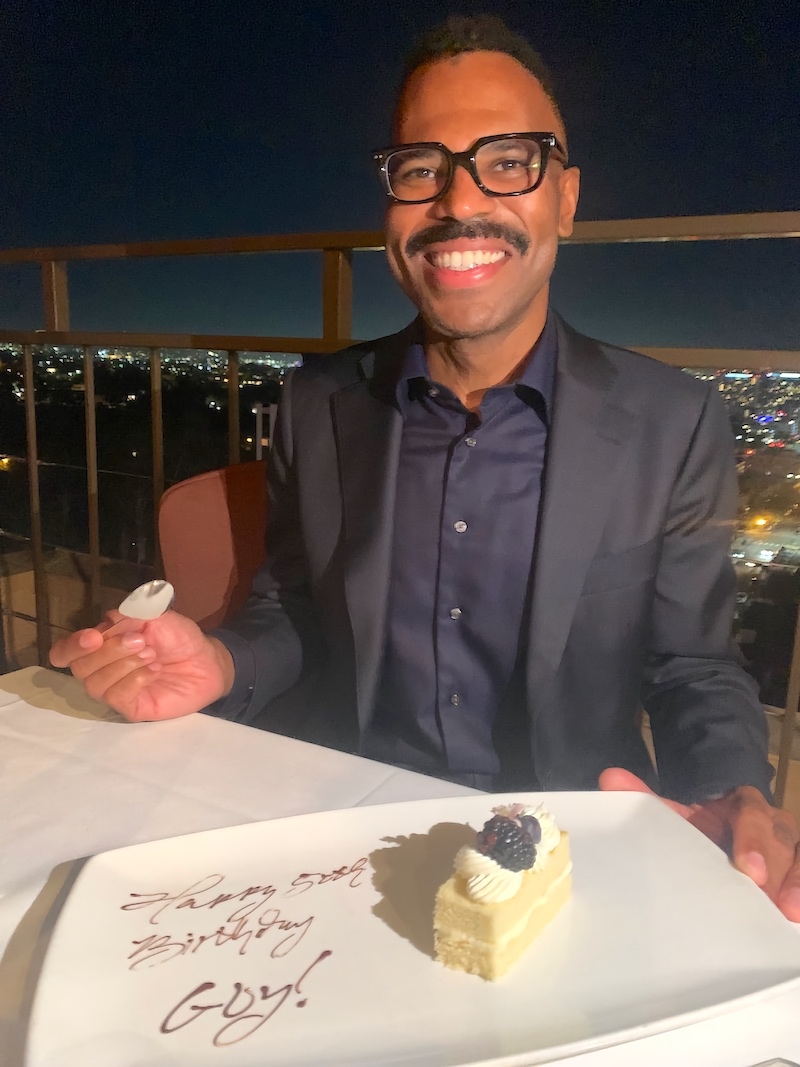
GUY: “This past year I learned to cherish those close relationships I hold dear in my life. Life is short! My top goal for 2022 is to continue to spend more time with my lifelong friends celebrating and enjoying life like I did on my birthday this past year.”

MARVYN: “And as for me, 2021 has been a roller coaster of a ride. Looking back, I realized that I have achieved a lot of the goals I set for myself. I was able to pause my life as a practicing occupational therapist back at home to pursue my Master’s degree here at USC. I was able to step out of the box (mainly because of quarantine and lockdowns back in 2020), and I pushed the boundaries of my comfort zones coming here as an international student. I have become more independent than I ever was, and I became more confident in myself and my capabilities as a person and as a professional. 2021 has been such a teacher for me, in such a way that even though you are miles away from your family, I am in such a great, and importantly very safe, environment to achieve my goals in life. I am overwhelmed with pride and humility at the same time because I didn’t expect to be who I have become today. If “2020 Marvyn” saw me today as he starts his 2021, he would be in disbelief at the sheer amount of growth he has had over one year.
2022 is a promising, yet daunting year for my life. I am slated to graduate with my Master’s degree this year and that my professional life will be catapulted swiftly into the real world. If there’s anything I want to look back on by the end of 2022, it is that I want to become a licensed and practicing occupational therapist here in the USA. No matter what hurdles may come my way, I do hope Destiny and Fate agree with my goals and guide me through the right paths. I am so excited at the same time nervous for what’s to come, but I hope 2022 would be my best friend much like how 2021 was to me.
SIDENOTE: I want to take more pictures around LA too (and that’s just a side quest I’m also looking forward to doing very soon)!”
And that’s a wrap! Thank you all for a wonderful 2021 and for reading our fun series of blogs over the past few days. New Years is tomorrow, and we here at the student ambassador team are so excited to greet 2022 with you.
⋯





